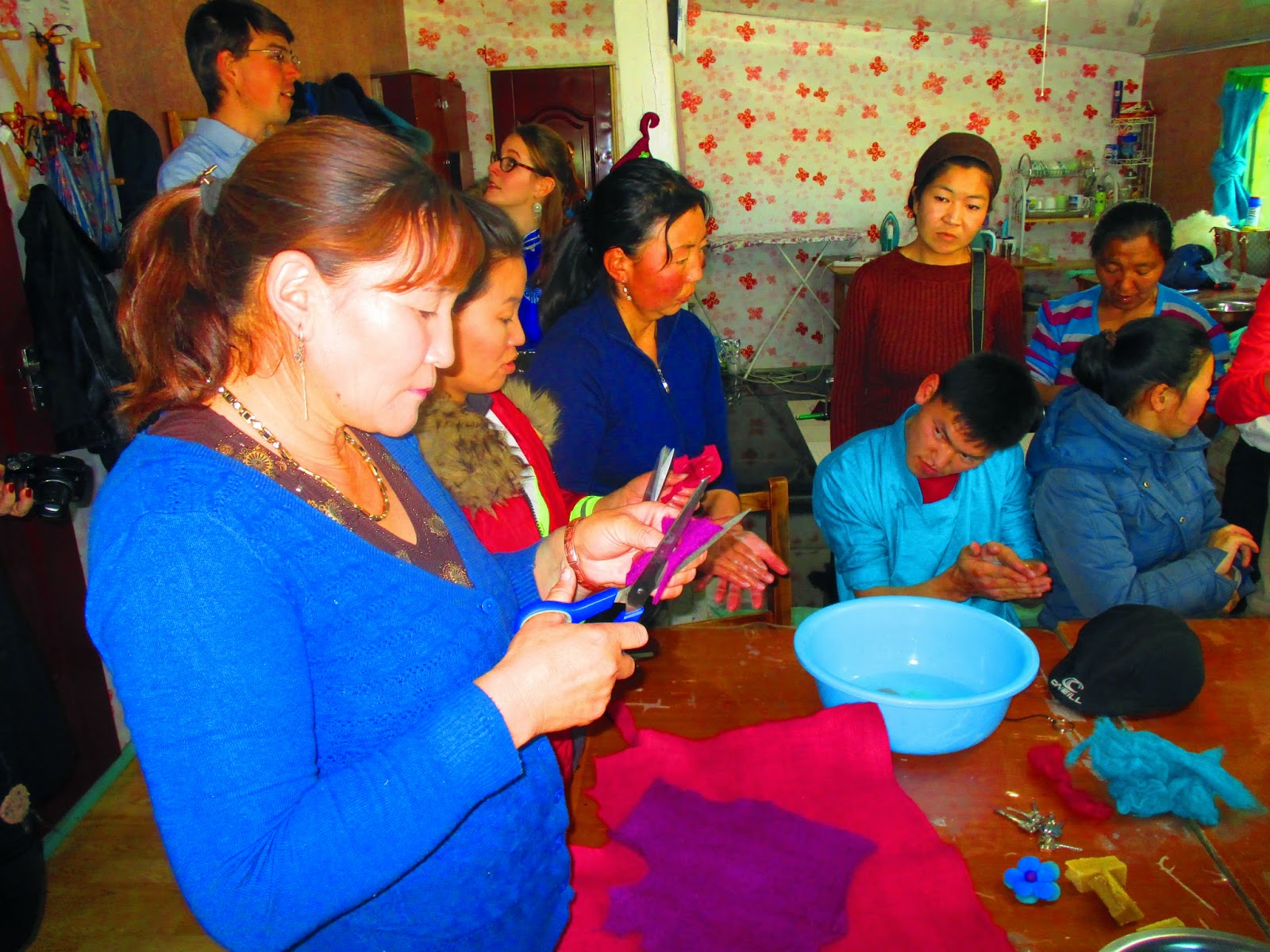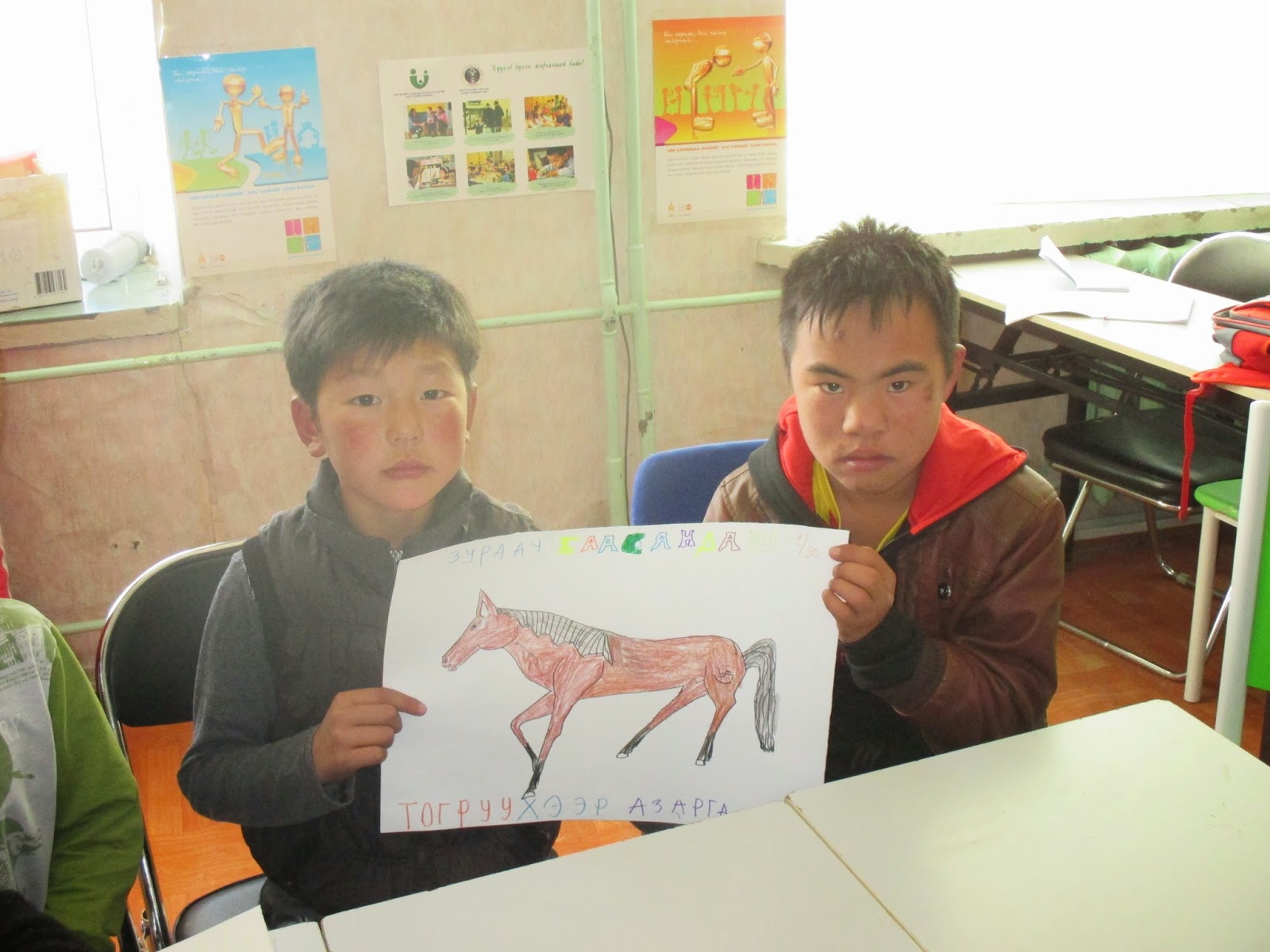 |
| Govi-Altai Happy Center For Disabled Youth and Friends Fall 2014 Semester |
UNESCO estimates that 98% of children with disabilities in developing countries do not attend
school and 99% of girls with disabilities are illiterate. Youth with disabilities are amongst the most marginalized and poorest group of all the youth in the world. Disabled youth often face dual disadvantages, as they are more likely to live in poverty even in developing countries. Moreover youth with disabilities in many cases experience rejection and isolation due to peers misconceptions, and discrimination.
In an effort to decrease stigmas, and increase social inclusion amongst Govi-Altai disabled youth, the Govi-Altai Happy Center for Disabled Youth and Friends was co-established by Dutch volunteer Magda Verboom, and myself on February 13, 2014, under the supervision of the Govi Altai provincial Children and Families Development Department. Our program aims to do the following:
• To provide children with disabilities access to fundamental education.
• To foster an environment for children with disabilities, that encourages social integration into the
community.
• To raise awareness around children with disabilities, through educating non-disabled secondary school children, and the community on what living with a disability entails, and how they can serve as advocates for disabled youth.
• To promote volunteerism amongst secondary school youth.
The Happy Center is the first program of its kind in Govi-Altai province. Our students are between 12-17 years old, and their disabilities include the following: blindness, Down syndrome, cerebral palsly, and epilepsy. All of the students have various types of learning disabilities, and up until the implementation of our program, they received education lessons during home visits from Magda. The Happy Centers holistic approach to education, and social inclusion, has significantly influenced the overall quality of life of our students.
Our spring session was piloted over the course of 3 months, and had a total of 10 disabled youth participants, and 20 secondary school youth volunteers. Participants met twice a week on Tuesdays and Thursdays, for 3 hours each session. The educational session covered topics such as basic arithmetic, and phonics. Immediately following the education session, the social integration aspect of our program, "Buddy time," which was modeled after the INGO Best Buddies International's Friendship program was held.
20 secondary school youth volunteers were selected by their school social workers based on their good attitude, and interest in the program. We paired the volunteers with our disabled youth participants. The youth volunteers were divided into two groups of 10, group A would meet on Tuesday and group B on Thursday. During "buddy" time, all of our youth participants were engaged in child friendly, adapted physical activity games, arts and crafts, movies, field trips to the local museum, karaoke restaurant, and various other activities.
An informational volunteer meeting was held prior to the start of the spring semester. During the session we covered topics such as: volunteer duties, disability education, how to work with persons with disabilities, and how to be an advocate for persons with disabilities in your community. We concluded our volunteer meeting with an activity that would give participants a better understanding of what life is like with a physical disability in Mongolia. Students had their legs tied together and were told to remain seated in their chair to simulate persons with disabilities that have limited mobility of their lower extremities. The volunteer was then read the following scenario, "You are alone at home, and want to make yourself something to eat in the kitchen. You don't know where your parents are, or what time they'll be back. What do you do? How do you feel?" One of the students responded by saying "I feel helpless, and angry that my parents would leave me here by myself. I also wish I had a wheelchair to use." Students were also blindfolded to simulate being visually impaired, and were asked to navigate around a classroom that wasn't accessibility friendly. By encouraging our volunteers to explain how they felt, it gave them a better understanding of what living with a disability is entails.
Our goal was to give our youth volunteers a new found perspective of the daily challenges persons with disabilities face here in Mongolia, by giving them the opportunity to empathize, and not sympathize with their buddy. We strongly believe that empathy is the foundation of advocating for disability rights. Frankly, teaching children about disabilities is simple: Creating an environment where they feel safe, and open to ask questions about disabilities is the first step. Children learn compassion and understanding when we teach them to value diversity and accept differences. Some of our youth volunteers had never interacted with a person with disabilities prior to the Happy Center. However, once they overcame their initial fears, they were able to look far beyond their buddies' disability, and uncover a world of similarities they had no idea they shared.
Soon after our program was implemented we were contacted by our local World Vision branch. And, in recognition of the program, World Vision donated teaching materials and games. A local television crew also broadcasted a report about the Happy Center for Disabled Children and Friends, which aired on our provincial network.
With the success of the program, my director at the Children and Families Development Department wanted to implement another session the following fall. My counterparts and I in preparation for the start of the fall session this past September made a few changes with regard to how we recruited youth volunteers. Instead of leaving the school social workers on their own to select volunteers, we worked together to design a survey that gauged students interest in the program, knowledge about disabilities, and attitude towards persons with disabilities. We also visited local family hospitals, to take the names of any new registered disabled children that we could add to the program.
Once again another volunteer meeting was held prior to the start of the first session for new volunteers, where we discussed disabilities, and inclusion. We invited the Govi Altai provincial representative from the Mongolian Commission for Human Rights to speak about her organizations work with disabled persons. Additionally, volunteers were given their duties and heard personal testimonies from the 2014 spring session volunteers. The Children and Families Department director, and children's rights specialist also spoke during the meeting to volunteers.
One of the biggest highlights from the fall semester, was a field trip to Artist Altai, an artisan co-operative, that makes a variety of wool and felt products. The artisans were amazing host. They taught the youth how to make their own keychains, and hair ties out of wool. We concluded the fall semester with a party, and award ceremony. Participants parents were also invited to attend the event.
We are currently working on a promotional video about the Happy Center to share with other PCVs, teachers, and social workers who are interested in implementing a similar program in their provincial capital, or village. In addition to the promotional video, my counterpart, and I will also organize a Happy Center workshop at the annual provincial teachers meeting this spring. The workshop will introduce topics such as disability education, inclusion, volunteer management, and program management. Since there are no occupational therapist in Govi-Altai, we have scheduled a pediatrician from the provincial hospital who specializes in disabilities to speak about her work.
In addition to the Happy Center, my primary project area is at the Govi-Altai UNFPA Youth Development Center (I will have a separate post about my work at the YDC later). The YDC opened this past fall, and one of our target groups are parents of disable youth. We are currently working with the parents to strengthen their life skills, and increase their knowledge about gender based violence, and sexual abuse towards persons with disabilities.
On behalf of the Govi-Altai Happy Center for Disabled Youth and Friends, I would like to thank World Vision, Bookbridge, Artist Altai, Govi-Altai Children and Families Development Department, and the UNFPA Youth Development Center for their support, and dedication to improving the lives of youth with disabilities in Govi-Altai.
Ultimately, the Govi-Altai Happy Center for Disabled Youth and Friends aims to foster a safe environment for disabled youth in the community, that provides them with access to education and social inclusion. We hope to implemented similar programs such as ours in other provinces, working within the Peace Corps Mongolia network of volunteers, and Enabling Individuals with Disabilities Task Force.
Happy Center Picture Gallery
Artist Altai Field Trip (November 2014)
Dance Lesson at the Children's Department
Lessons and other activities
Volunteer Meeting (September 2014)















































































